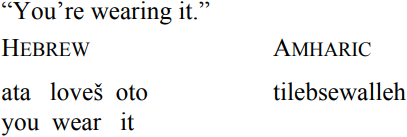


 Grammar
Grammar
 Tenses
Tenses
 Present
Present
 Past
Past
 Future
Future
 Parts Of Speech
Parts Of Speech
 Nouns
Nouns
 Verbs
Verbs
 Adverbs
Adverbs
 Adjectives
Adjectives
 Pronouns
Pronouns
 Pre Position
Pre Position
 Preposition by function
Preposition by function 
 Preposition by construction
Preposition by construction
 Conjunctions
Conjunctions
 Interjections
Interjections
 Grammar Rules
Grammar Rules
 Linguistics
Linguistics
 Semantics
Semantics
 Pragmatics
Pragmatics
 Reading Comprehension
Reading Comprehension|
Read More
Date: 7-3-2022
Date: 10-1-2022
Date: 8-3-2022
|
Semitic
A. The best-known Semitic languages are Arabic and Hebrew, spoken in the Middle East, along with a few others, such as Aramaic (the language of Jesus). There are records of many extinct Semitic languages, such as Akkadian (written in cuneiform) and Phoenician.
B. Semitic languages are almost unique in the world in basing words on roots of three consonants, creating a range of related meanings by altering the vowels around and between them and adding prefixes and suffixes.
C. For example, in Arabic, the root K-T-B has to do with the concept of writing. Here is the way the language creates a wide range of meanings from this one root:

The dash over the vowel means that the vowel is long; notice that the difference in vowel length can make a difference in meaning. The apostrophe stands for a glottal stop, as in the first sound one makes in saying “uh-oh.”
D. Language families can spread across very different cultures and peoples. Most Semitic languages are actually spoken in Ethiopia, across the Red Sea from the Middle East. This is why, for example, “night” is laila in Hebrew and leylat in Amharic, the major Ethiopian Semitic language.
E. The sentence “You’re wearing it” looks quite different in Hebrew and Amharic. But if we look closely, we can see a similar trio of consonants, the Semitic root for wearing clothes. Hebrew has L-V-SH, and lurking in the Amharic word is the similar L-B-S.

|
|
|
|
دخلت غرفة فنسيت ماذا تريد من داخلها.. خبير يفسر الحالة
|
|
|
|
|
|
|
ثورة طبية.. ابتكار أصغر جهاز لتنظيم ضربات القلب في العالم
|
|
|
|
|
|
|
سماحة السيد الصافي يؤكد ضرورة تعريف المجتمعات بأهمية مبادئ أهل البيت (عليهم السلام) في إيجاد حلول للمشاكل الاجتماعية
|
|
|